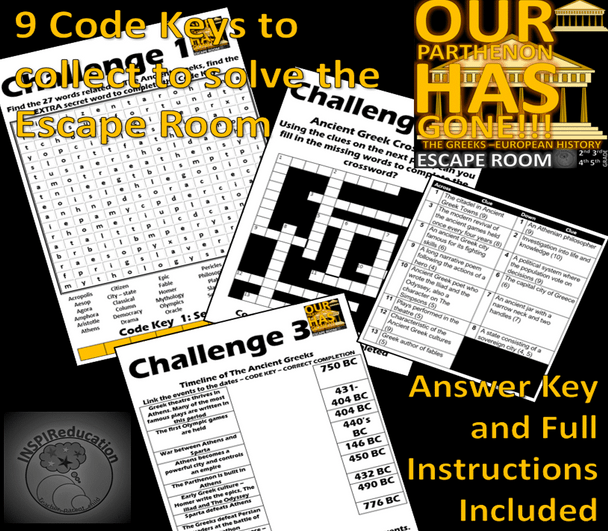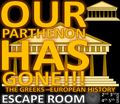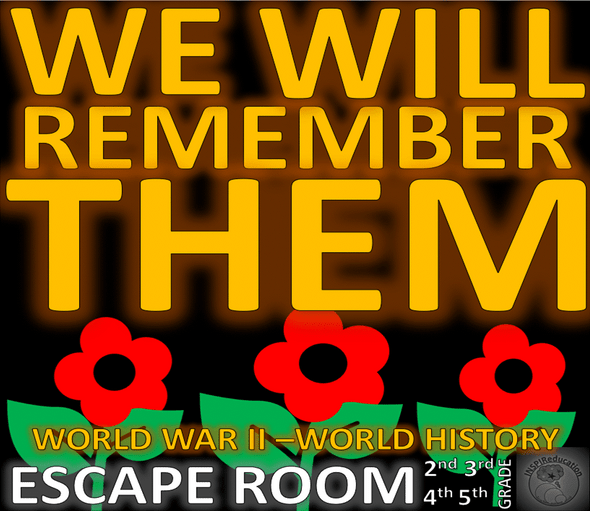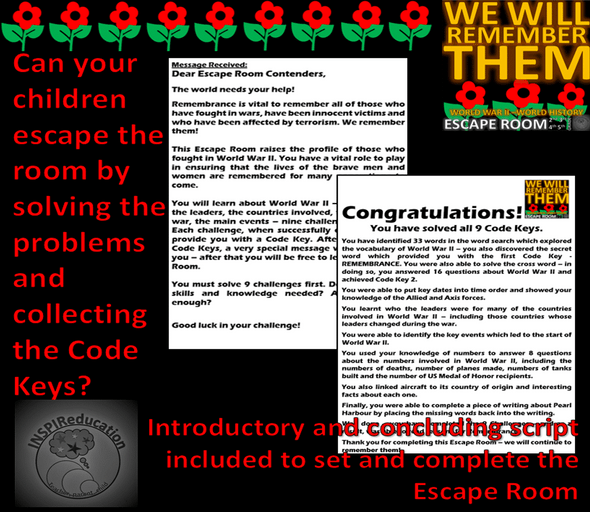Description
Using an Escape Room to develop curriculum knowledge is an exciting activity that will inspire learners from 2nd Grade to 5th Grade.
The curriculum content of this Escape Room is linked to:
- History of the World– Ancient Greeks
- Cultural understanding of an Ancient Civilisation
- Legacy of an Ancient Civilisation on our lives today
- Chronological understanding
The aim of the Escape Room is to provide jeopardy for the children to work under pressure to solve 9 clues to help develop their growing knowledge of the Ancient Greeks.
The 9 Challenges within this Escape Room will support knowledge and understanding of the events, the society, the religious beliefs and innovations of this ancient civilisation.
Before beginning, you will need to prepare the following:
- A copy of the Pupil Workbook (Code Key Booklet) for each group
- Team Table Labels printed for students to have on their tables
- IT sources and research materials – if required by your children
- Initial Starting Script sharing the problem to the children
- Completion Script celebrating the completion of the challenge
- Teacher Answer booklet to hand to review the challenges as the children work through them.
Children do not need prior knowledge of the Ancient Greeks to complete this Escape Room, however, the ability to have access to research resources will support the answers. This Escape Room is ideal as a review of learning to identify what the children have learnt and retained as a result of completing the study unit of Ancient Greeks.
The activity begins by the teacher reader the Initial Message received. It clearly tells the children that they are required to help raise knowledge and learning in the Ancient Greeks as the Parthenon has gone – simply disappeared and it is being ransomed for the development of knowledge across the world on the lives and legacy of the Ancient Greeks. The way to bring the Parthenon back safely is to successfully complete 9 Challenges – each one will provide a Code Key, enabling the children to move onto the next Challenge and so on until all 9 are completed.
After the 9th activity – the teacher can then read the end script which reviews the activities, the success criteria and the learning that has taken place during the completion of the escape room. Both starting and ending scripts, together with the Team Name Table Labels are contained within the Resources Pack.
Each activity focuses and builds the children’s knowledge of the Ancient Greeks:
The 9 activities are based on the following outcomes:
- Word Search to introduce 27 key words related to the Ancient Greeks – as well as finding a secret word which is hidden and is Code Key 1 which the children must find to move to Challenge 2.
- Crossword to complete which introduces further Greek information to the children – there are 14 clues to solve.
- Timeline of key events within the Ancient Greek Period from start to Roman rule
- The names and roles of the top 10 Ancient Greek Gods
- Root word investigation and their meanings used today from the Ancient Greek
- The difference between Athenian and Spartan society – using hierarchical social pyramids. Comparison between the two.
- Greek Alphabet – symbols and names
- Aesop’s Fables – Complete the title of the fable
- Ancient Greek Engineering and Invention
When all 9 activities are completed, and the children have gained the correct Code Keys from each activity, the teacher can read the final communication detailing how the children have been able to save the Parthenon – which is now safely back in its rightful position.
Setting up the Escape Room
1. Children should be split into groups of no more than four and be placed in their own workspace.
2. Access to IT and research materials should be provided to allow children to research answers to questions and review their own knowledge, as well as checking answers.
3. Each group should have a Code Key Booklet and decide on a team name – they can then write their team name on the booklet.
4. Teams to set up a working area within the classroom area and place their Team Name Table Label prominently.
5. Teacher to read the Initial Message to the children to set the challenge in context. Discuss what this means, and what the activity entails.
6. Turn to Code Key 1. Agree with the children a set time to complete the problem in – this ensures that the children stay on task and maintains the Escape Room element of working under pressure.
7. At the end of the time, children should have filled in the Code Key in their booklet. The teacher can then check the accuracy of all the groups and talk through the responses the children should have.
8. Move on through the remaining challenges until all 9 have been completed.
9. For those groups who have been successful, they are then able to read the completed statement where they find out if they have escaped the Escape Room!
There are other ways of running Escape Room activities, for example, each activity could be set up on 9 tables and the children then move from table to table completing the activity. This would reduce the need for as many resources, and access to non-fiction sources and Internet Resources could then be targeted at specific Challenges.
The Escape Room should last for 2 hours.
We hope that your children enjoy this Escape Room.
Thank you for visiting our store,
Best wishes
INSPIReducation



















